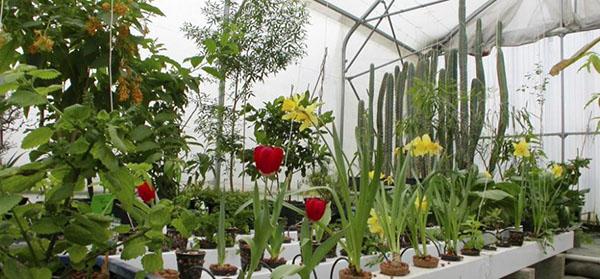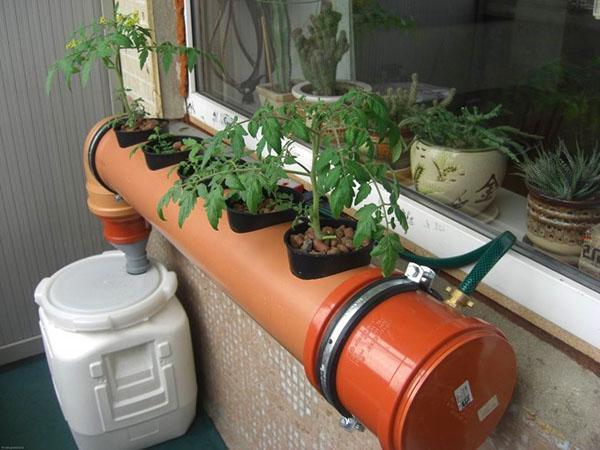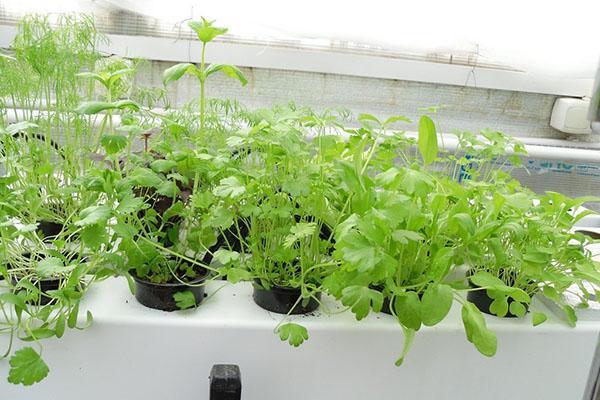How to properly use hydroponics to grow vegetables and flowers?
 Vegetables, herbs and flowers are successfully grown at home without using soil. This technique is known as hydroponics. The whole essence of this technology comes down to creating a favorable environment for the development of the root system. Thanks to the saturation of the plant with oxygen, as well as nutrients, it will be able to flourish and bear fruit.
Vegetables, herbs and flowers are successfully grown at home without using soil. This technique is known as hydroponics. The whole essence of this technology comes down to creating a favorable environment for the development of the root system. Thanks to the saturation of the plant with oxygen, as well as nutrients, it will be able to flourish and bear fruit. 
The leading role in obtaining a high-quality and abundant harvest is played by the nutrient solution. The hardness of water and the content of soluble salts in it must correspond to the norm - 1.5-3 g per liter of liquid.
Greens
 The cost-effectiveness of this technique, which includes the rational use of water and space, cannot be underestimated. It is very easy to set up a hydroponic plant at home to grow aromatic greens. Its yield is so great that many people use this technology commercially for forcing:
The cost-effectiveness of this technique, which includes the rational use of water and space, cannot be underestimated. It is very easy to set up a hydroponic plant at home to grow aromatic greens. Its yield is so great that many people use this technology commercially for forcing:
- onions on a feather;

- parsley;
- fennel;
- salad;
- dill.
Since a special substrate is used as soil, the plant receives a sufficient amount of nutrients. In this regard, it devotes all its strength to the formation of a dense top, and not powerful roots. You can make such a construction as follows:
- Prepare a plastic pallet. You need to choose containers in black with a matte finish. Such a surface does not let light into the middle, and prevents the formation of algae in the water. In stores, you can find special trays for new generation hydroponics.

- Craft a floating platform. To do this, you need to cut out a sheet of foam of the appropriate size. Make holes in it, the diameter of which will be the same as the pots of herbs. However, they must be well fixed in the funnels and not fall through. The distance between the holes should be chosen medium so that the grown bushes do not interfere with each other.

- Prepare planting containers for the root system. These special hydroponic tanks are baskets that look like Soviet shopping bags.

- Purchase an aquarium type air compressor. It is worth remembering that hydroponics is a technology that involves the use of special equipment for growing plants. Such installations ensure the saturation of the nutrient solution with oxygen.

You can darken the surface of the pallet with black paint. Moreover, some people use food foil for this purpose. Such a layer will also protect the substrate from overheating, beating off heat and light rays.
 Now you can start planting seeds. The filler can be moss, hay or rock wool. Hard or large substrates are not suitable for growing greenery. Before use, the planting material should be thoroughly wetted.
Now you can start planting seeds. The filler can be moss, hay or rock wool. Hard or large substrates are not suitable for growing greenery. Before use, the planting material should be thoroughly wetted.  Fill the tray with the solution so that 1/3 of the pots are in it.The water supply with fertilizers should be replenished every 14 days (in the summer period this should be done much more often), and it should be completely replaced once a month.
Fill the tray with the solution so that 1/3 of the pots are in it.The water supply with fertilizers should be replenished every 14 days (in the summer period this should be done much more often), and it should be completely replaced once a month.
Instead of pots, some have successfully used conventional disposable cups. Only in them it is necessary to carefully cut holes along the entire perimeter.
Vegetables
 Make your own primitive hydroponics - equipment for growing vegetables is possible if you adhere to a certain scheme. However, you still have to use specialized devices from the store.
Make your own primitive hydroponics - equipment for growing vegetables is possible if you adhere to a certain scheme. However, you still have to use specialized devices from the store.  The process of building such a homemade structure consists of the following stages:
The process of building such a homemade structure consists of the following stages:
- Purchase of a container (15 l), as well as several flower pots.

- A lid must be cut out of the foam to cover the tank. If this is an ordinary bucket, then you can make a special lid on it from a dense material. The holes correspond to the size of one or more pots.
- Cut 2 funnels at the bottom of each container. According to hydroponic technology, they are necessary for the supply of nutrient solution and the removal of excess moisture.
- In the first hole, you need to fix the tube that is connected to the compressor (for example, an aquarium pump). The second tube serves as a drainage component to prevent flooding.

- Now the pot (if desired, several) needs to be filled with planting material: expanded clay, vermiculite (a mineral with a layered structure), crushed stone, crushed coconut shell, perlite, coarse sand mixtures, gravel.

- Seedlings are planted. In this case, the roots should be carefully straightened so as not to damage them.
- Fill a bucket with specially formulated nutrient fluid.
- Switch on the compressor.

At the first stage, you need to set a timer with a frequency of 15 minutes. This allows the system to uniformly fill the substrate reservoir with fluid. By the next run, excess moisture will be removed from the pot.
 The technology of the above do-it-yourself hydroponics is widely used for growing cucumbers and tomatoes at home. Such crops can rightfully be awarded the title of organic food.
The technology of the above do-it-yourself hydroponics is widely used for growing cucumbers and tomatoes at home. Such crops can rightfully be awarded the title of organic food.  They do not grow in soil, which would accumulate metals or fertilizer residues, but in a specially prepared solution. At the same time, the gardener should not worry about pests that often grow in the soil, or about diseases that affect crops.
They do not grow in soil, which would accumulate metals or fertilizer residues, but in a specially prepared solution. At the same time, the gardener should not worry about pests that often grow in the soil, or about diseases that affect crops.
Flowers
 Florists will also be interested in this technology. Lush and dense blooms on the windowsill will be able to delight households and neighbors all year round. In order not to torment readers for a long time what hydroponics is for flowers, it is worth getting down to business right away. Perhaps this is the simplest hydroponic plantwhich is used in horticulture. For its construction you will need:
Florists will also be interested in this technology. Lush and dense blooms on the windowsill will be able to delight households and neighbors all year round. In order not to torment readers for a long time what hydroponics is for flowers, it is worth getting down to business right away. Perhaps this is the simplest hydroponic plantwhich is used in horticulture. For its construction you will need:
- Transplant the flower into a ceramic or clay pot with a hole on the bottom and side walls. The diameter of each of them is either 1 cm or 1.5 cm.

- Planting granular material (options are listed above) should be sieved through a sieve to separate it from unnecessary impurities. The filter mesh diameter varies from 0.1 to 2 cm. Then the soil must be treated with a disinfectant (potassium permanganate solution).

- Plant young shoots a few cm deeper than usual.
- Submerge the pot in a container of water half full. After 7 days, replace the liquid with the prepared solution.

- When new roots appear (they will become visible through the holes at the bottom of the flowerpot), it is necessary to make an air "cushion" for them by slightly raising the pot. Then the roots will get enough air and will not die off.

The transplant should be carried out during the warm season (spring or summer). In a cool microclimate, they will not be able to successfully adapt to new conditions.
DIY hydroponics can be made from pallets, buckets, or regular shopping bowls. It is advisable to buy basins of dark shades so that they do not let light through.Among other things, tanks should be made of durable materials that will not chemically react with other substances or change their structure under the influence of temperature.  However, these items are advised to be used only at the first stage, until new roots appear.
However, these items are advised to be used only at the first stage, until new roots appear.
Hydroponics is not recommended for varieties whose root system is prone to rotting. It is prohibited for succulent plants (do not require frequent watering, withstand drought), as well as bulbous flowers.
When the water is replaced with a saturated solution, then the distance between the pot and the external tank is increased from 6 to 10 cm. If you buy special equipment for hydroponics, then in such installations all this is provided by the manufacturers.
Extra courtship
 However, the presence of such a device does not replace spraying of the plant. In addition, rotted or dried leaves / stems should be regularly pinched off. Every 30-40 days, it is necessary to monitor the level of acidity and the concentration of nutrients. It is important to change the solution periodically. At the same time, it is advised to disinfect dishes, roots and substrate. To do this, you can use ordinary potassium permanganate diluted with water.
However, the presence of such a device does not replace spraying of the plant. In addition, rotted or dried leaves / stems should be regularly pinched off. Every 30-40 days, it is necessary to monitor the level of acidity and the concentration of nutrients. It is important to change the solution periodically. At the same time, it is advised to disinfect dishes, roots and substrate. To do this, you can use ordinary potassium permanganate diluted with water.
In the winter season, the concentration of fertilizers is halved. In this case, it is necessary to reduce the water level to the minimum mark. Such precautions will allow the flower to survive the dormant period safely.
Fertilizers and solution preparation
 Moreover, you should choose the right fertilizer for hydroponics. The formation of a nutrient medium largely depends on the result that the gardener wants to get.
Moreover, you should choose the right fertilizer for hydroponics. The formation of a nutrient medium largely depends on the result that the gardener wants to get. 
 For flowers, herbs and vegetables, you need to select different components. Here is some of them:
For flowers, herbs and vegetables, you need to select different components. Here is some of them:
- magnesium (sulfate or liquid nitrate) and calcium (granular nitrate) promote enhanced root development;
- phosphorus (orthophosphoric acid) stimulates the flowering process, and also accelerates the growth of the stem;
- potassium (nitrate or monopotassium phosphate) is responsible for the color of leaves and shoots of the crop.
Organic fertilizers (including urea) are not suitable for this technology. Their constituent components quickly spoil the essence and it turns sour.
This root feeding technology is a whole art. Indeed, instead of soil, water is used here, which must be saturated with nutrients and trace elements.  In most cases, a ready-made solution for hydroponics is best bought in specialized stores. The acidity of such formulations ranges from 5.8 or 6.5 pH. These are mainly complex fertilizers. To independently prepare a nutrient base for crops, a gardener needs to take:
In most cases, a ready-made solution for hydroponics is best bought in specialized stores. The acidity of such formulations ranges from 5.8 or 6.5 pH. These are mainly complex fertilizers. To independently prepare a nutrient base for crops, a gardener needs to take:
- Water purified through a filter. It should stand for 24 hours. Liquid temperature - room temperature (18-20 ° С), volume - 1 liter.
- On an accurate electronic balance weigh 1 g of nitrogen and 2 g of potassium, phosphorus - 0.5 g, and magnesium - 0.3 g;
- To prepare another recipe (Knop), you need to take 0.25 g of magnesium sulfate and potassium phosphate, potassium chloride - 0.125 g, one gram of calcium saltpeter and 0.0125 g of ferric chloride.

- Then dissolve each chemical in turn in a small amount of liquid.
- Pour 700 ml into a bowl and start pouring the prepared solutions separately. In this case, stir very thoroughly.
- When all components are mixed, then it is important to top up the volume of water to one liter.
 It should be borne in mind that iron-containing substances are extremely "capricious", therefore they can precipitate. An alternative is ferrous sulfate (1.5 g) in tandem with citric acid (1.7 g). They are bred separately, but then mixed in 0.5 liters of water.
It should be borne in mind that iron-containing substances are extremely "capricious", therefore they can precipitate. An alternative is ferrous sulfate (1.5 g) in tandem with citric acid (1.7 g). They are bred separately, but then mixed in 0.5 liters of water.
A properly prepared mixture will have no sediment. To avoid this, you do not need to mix all the ingredients at the same time and then dissolve them in water.
Lamps
 Economical hydroponics lamps play an important role in the full growth of vegetables and flowers, which help them grow quickly.It is important for such "house" plants to get enough light. For this, gardeners use these types of energy-saving lamps:
Economical hydroponics lamps play an important role in the full growth of vegetables and flowers, which help them grow quickly.It is important for such "house" plants to get enough light. For this, gardeners use these types of energy-saving lamps:
- luminescent (durable, their spectrum includes the rays necessary for photosynthesis);
- incandescence (they give off maximum heat, but if there is no ventilation in the room, then they lead to the formation of mold);
- gas discharge (metal halide, sodium, and mercury).
 They are installed at a distance of 0.5 m for shade-loving plants and 15 cm for varieties that need more than 12 hours of light. These lamps for hydroponics should be selected individually. After all, crops grown in this way are considered quite vulnerable.
They are installed at a distance of 0.5 m for shade-loving plants and 15 cm for varieties that need more than 12 hours of light. These lamps for hydroponics should be selected individually. After all, crops grown in this way are considered quite vulnerable.
Hydroponics at home - video